Beyond the Fitness Fad
Personal trainers offer clients much more than a physical workout.
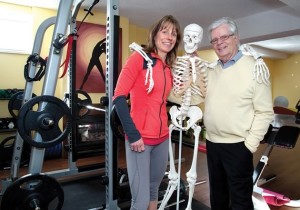
Diether Weeren (right) relies on trainer Nikola Boadway to keep him in shape – just as he relies on a mechanic to keep his car running. Photo by Rosemary Hasner / Black Dog Creative Arts.
“I feel my body and my car have a lot in common,” says Diether Weeren. In his early 70s, Diether is increasingly aware that his quality of life depends on keeping his body tuned up. He recognizes it would be less expensive if he learned how to fix his automobile – and his body – himself. But Diether is neither an expert mechanic nor a fitness pro, so he willingly pays professionals to do both jobs.
Diether is part of a trend driven by a growing awareness of the links between health, well-being, fitness and nutrition. This awareness extends to people of all ages and fitness levels, with recreational tennis players and aging baby boomers as inclined as aspiring Olympians to put in the time, energy and money needed to keep their bodies in tune.
Sandy Irwin, who operates 2bfitt Training Classes and Events in Orangeville, has racked up more than 25 years as a personal trainer and finds herself working with more and more corporate clients. What began as a fad among working professionals, she says, has turned into a fitness phenomenon. “Business professionals wanted more of a workout than their aerobic classes offered. They had money, but were short on time. When they added a workout with a personal trainer to their Day-Timer, they got specialized and professional service, and were able to achieve their goals.”
Nikola Boadway, the Palgrave-based personal trainer who puts Diether through his paces, explains what’s behind the trend. “Sitting,” she says, “is the new smoking.” Nikola didn’t coin this phrase, but she has made it her life’s mission to help others avoid or reduce the effects of spending hours in front of a computer.
With rod-straight posture, a waist the size of my thigh and the ability to do eight chin-ups, which is eight more than I can do, Nikola, like most of the personal trainers I met, doesn’t limit her expertise to physical fitness. To varying degrees, personal trainers also promote mental health and nutrition, and Nikola, who sees up to 60 clients a week in one-on-one, semi-private and group sessions at Palgrave Personal Training, views herself as a holistic lifestyle coach. “It’s better,” she says, “if the people I train combine their workouts with drinking plenty of water and eating healthily.” She also recognizes that stress can undo many of the benefits of a workout.
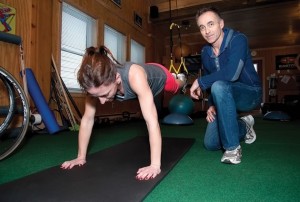
In Hockley Village, Fulvio Cubello sees twice as many women as men. “Women,” he says, “are easier to motivate, more disciplined.” Photo by Rosemary Hasner / Black Dog Creative Arts.
According to experts at the Mayo Clinic, the longer we spend sitting in front of a TV or computer screen, the greater our chances of experiencing health problems or even premature death. One study compared adults who spend less than two hours a day staring at a screen for recreational purposes with others who do the same thing for more than four hours. The risk of death from any cause was nearly 50 per cent higher among those who spend the longer time, and the risk of dying of cardiovascular disease, such as angina or a heart attack, was about 125 per cent higher. Moreover, the increased risk was independent of factors such as smoking and high blood pressure. Sitting, experts say, seems to stall the body’s ability to break down fats and sugars, which explains not only the apparent obesity epidemic, but also many other health problems.
To help her clients build a well-balanced, functional body, Nikola focuses on mobility, core strength and correcting posture. Using a clever illustration that shows how our modern lifestyle encourages us to hunch over computer desks or stare down at cell phones, she makes her case: by improving posture we can avoid a lot of pain, increase energy levels and look better, too.
Spending long periods scrunched over a screen can shorten the muscles in the front of the body and slacken those in the back. Dowager’s hump was often considered an affliction of older women, but computer and cellphone users beware. That unsightly rounded back is but one of the ailments you can look forward to if you don’t take steps to raise your chest and prevent your shoulders from caving in.
According to experts, the longer we spend sitting in front of a TV or computer screen, the great er our chances of experiencing health problems or even premature death.
My preconceived notion was that personal trainers, who charge in the range of $75 an hour depending on their experience, are well-informed cheerleaders whose function is to push clients a bit harder in the gym than they might push themselves, to provide an incentive similar to a weekly weigh-in at a weight-loss clinic and to hand out some tips on a personalized workout routine. It turns out that personal trainers do all this – and much more.
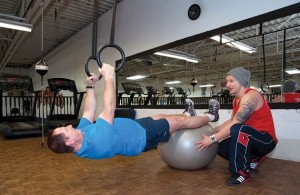
Trainer Tony Fenech has been putting Orangeville mayor Rob Adams through his paces for about four years, usually in the gym at Big Tyme Fitness and Boxing, but sometimes for variety on the playground equipment of a local school. Photo by Rosemary Hasner / Black Dog Creative Arts.
For about four years Orangeville mayor Rob Adams has been working out with Tony Fenech, a high-energy, Orangeville-based trainer. Rob praises Tony’s motivational skills, but is most impressed by his technical advice. “Tony,” says Rob, “identified my weaknesses and corrects my form.”
“Form,” an everyday term in the world of personal training, refers to the motion used to complete a particular exercise. Correct form uses the proper muscles. But letting our strengths compensate for our weaknesses is human nature, and people often do this when working out on their own. “The body will always find a way to cheat,” says Nikola. Personal trainers use their knowledge of how the human body works to identify problems and zero in on muscles that are less strong, designing an exercise regimen that often specifically avoids the use of dominant muscles.
Nikola gave me a series of exercises designed to use the muscles I had allowed to slacken, and then made sure I did the routines properly – because even a slight change in form can be enough to allow one set of muscles, usually the strong ones, to take over from another, usually the weaker ones.
Personal trainers also design training routines that help clients stay challenged and motivated as they strive to meet their personal goals. “If you continue to do the same exercises without progression,” says Nikola, “you will also get the same results and potentially lots of wear and tear. Training is about being accountable and working with focus, consistency and a willingness to push yourself past comfortable. If you just do the same thing over and over again, most people will get bored and give up.”
Tony uses an imaginative array of equipment and exercises to keep his clients’ interest. He can, for example, create an amazing workout from a big fat old rope and a couple of plastic discs. Rob Adams recalls the day Tony took him to a playground behind a local school. “Today,” Tony told him, “we are going to just use this playground equipment.” He then put Rob through his paces using swings, slides and monkey bars.
The relationship between client and trainer can run deep. Bonnie Richmond, a Belfountain resident, has worked with personal trainers for years. Though she doesn’t lack motivation and has learned the routines she needs to keep herself fit and strong, Bonnie keeps up with her personal trainer anyway. “The main reason I keep seeing her is because we’ve become friends,” says Bonnie. “I really like her.” She also turned to her trainer to help with a recent injury. “My trainer gave me exercises that didn’t exacerbate the problem. She also gave me exercises that helped me recover.”
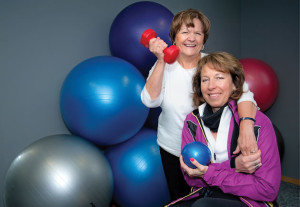
Nancy Frater (left) practises cardio and strength exercises with Terri Holden, whom she affectionately calls “the princess of pain.” Photo by Rosemary Hasner / Black Dog Creative Arts.
For seven years Nancy Frater, owner of BookLore in Orangeville, has been seeing Terri Holden of Fit for Your Life Personal Training. Though she jokingly calls Terri “the princess of pain,” Nancy says she has no intention of retiring anytime soon, and she credits Terri’s cardio and strength-building routines with giving her the energy to keep going.
Like many people I spoke with, especially women, Nancy says, “I’m not comfortable going to a big gym.” For some, venturing into places like GoodLife Fitness can be intimidating. When I visited the GoodLife facility in Orangeville, the trainer who showed me around pointed out and rattled off the names of a dizzying array of machines: elliptical trainers, TRX systems, treadmills, rowing machines, adductors, abductors and so on.
But when I asked about some specific equipment Nikola had suggested I use, he showed me the exact machines I required and demonstrated how to use them. It was great for me to be able to supplement my session with Nikola by using equipment specifically designed to isolate the muscles she told me needed strengthening. And knowing what to ask for reduced the intimidation factor.
Though machines can be helpful in fitness training, most of the trainers I spoke with focused on “functional” training. The Mayo Clinic defines functional training as exercises that “train your muscles to work together and prepare them for daily tasks by simulating common movements you might do at home, at work or in sports.” So rather than use a machine that might require use of only your bicep or hamstring, functional exercises use these muscles, as well as the associated ones you might need to swing a tennis racquet or pull a heavy bag of gardening soil out of the trunk of your car.
André Leitert owns Riverdale Fitness Mill in Inglewood and sells a complete line of high-quality fitness equipment through his company National Fitness Products. André points out that “functional training is good way of training, but it’s easy to lose proper technique if you’re not coached properly.” A trainer can help you zero in on the equipment that will give that wayward muscle an extra workout and bring it up to par with your strengths.
As women age, osteoporosis becomes more of a concern, and it is widely accepted that weight training can slow or even halt this debilitating disease.
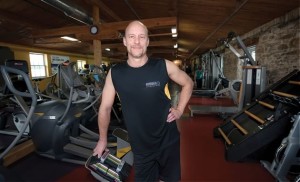
André Leitert, owner of Riverdale Fitness Mill, says using good equipment with proper coaching assists multi-muscle workout. Photo by Rosemary Hasner / Black Dog Creative Arts.
A trend at Riverdale Fitness Mill, André says, is the rising number of women using strength equipment for resistance training. Perhaps because they have turned to personal trainers for advice, women are becoming more comfortable using the pulleys, weights and levers that make up exercise equipment.
Fulvio Cubello, who runs Esteem Fitness and Wellness in Hockley village, sees twice as many women as men. “It sounds like I’m putting women on a pedestal,” Fulvio says, “but they are easier to motivate, more disciplined and they do the homework I give them.” Many of Fulvio’s female clients are also older than 40. As women age, osteoporosis becomes more of a concern, and it is widely accepted that weight training can slow or even halt this debilitating condition.
Whereas many of Fulvio’s male clients are coping with weight gain, the women he works with more often complain of feeling sluggish. So he designs programs to cope with these differences. And he notes another way in which women are conscientious clients: “Women are more inclined to change to a healthier diet than men.” Then, echoing Nikola, he adds, “You can’t diet properly without exercise and you can’t exercise properly without a good diet.”
Though personal training is a relatively new and largely unregulated profession, all the trainers I met are certified in some way. André Leitert says he has seen effective personal trainers with a ton of certificates and others who have trained themselves. “The important thing if you are a personal trainer,” he says, “is that you have to be in shape. And you have to have experienced the training that you’re prescribing to your clients.”
Tony Fenech, Rob Adams’ trainer, is an example of someone who has worked his way up through the ranks. I met with Tony beside the boxing ring at Big Tyme Fitness & Boxing in Orangeville. His battered nose and short, quick boxer-like movements seemed to contrast with the very healthy-looking green blender drink he sipped as we talked. Tony explained how he had been a high school tennis champ. Then he moved on to skateboarding and boxing, excelling at both.
He vividly recalls the day he discovered his own strength. When his father, whom Tony describes as extraordinarily strong, and a friend couldn’t lift a concrete slab, Tony brushed aside the “old guys” and picked up the slab by himself. Then he carried it up a flight of stairs. Then he carried up 14 more slabs. From that point his relationship with his dad changed forever, and Tony added weightlifting to his long list of athletic endeavours.
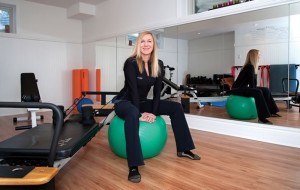
Sandy Irwin in her Orangeville studio: “Business professionals wanted more of a workout than their aerobic classes offered.” Photo by Rosemary Hasner / Black Dog Creative Arts.
Tony has accumulated an impressive list of certifications through Canadian Fitness Professionals, aka canfitpro, and works with people ranging from the mayor to professional boxers and horseracing jockeys. But to do what an effective trainer such as Tony does, it’s important to have a good grasp of anatomy, nutrition and even psychology – and to be willing to keep learning.
One way in which the industry has advanced, says Sandy Irwin, is that there are now great courses for aspiring trainers. They still require time in the gym, she says, but new trainers come out of these programs with solid knowledge.
In one exceptional case, Renée Holden, a trainer with a home-based studio near Belfountain, was called upon to work with Bill Acheson, an aging baby boomer who, as a result of a cardiac arrest induced by sleep apnea, had been deprived of oxygen before first responders arrived at his Hillsburgh home. After four months of rehab in Toronto for his resulting brain injury, Bill scored 6 out of 30 on the Montreal Cognitive Assessment test, well below the level of 26 or higher considered normal. Experts told Bill and his wife Dianne that further improvement in his cognitive skills would likely be slight.
But Dianne had been working with Renée for years, and unwilling to accept the verdict, she took Bill to see her. “During the first visit,” says Dianne, “Renée noticed that while Bill could imitate her actions, he didn’t understand how to even raise his leg when given verbal directions.”
Renée recalls spending hours learning about Bill’s condition, called anoxic brain injury. She then turned to studying neuroplasticity, the idea that, with repetition, neural pathways in the brain can be re-established.
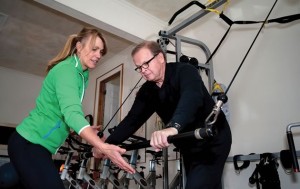
Trainer Renée Holden helped put Bill Acheson well on his way to recovery from disabilities resulting from a brain injury. Photo by Rosemary Hasner / Black Dog Creative Arts.
Last December, 15 months after Renée began her painstaking treatment to help Bill relearn how to perform the most basic movements, his score on the cognitive assessment had risen to 27. And he is now in the process of getting his driver’s licence back.
If we want to be pain-free and vibrant well into our senior years, we must live a healthy, active lifestyle.
Most people who work with a personal trainer face less daunting challenges than Bill, but like Renée’s star pupil they need to do more than push additional weight to achieve success. The study that investigated the risks of sitting also found that visiting the gym for a few hours a week or doing other vigorous exercise doesn’t significantly offset the risks. Instead, as any experienced trainer will say, you need to be generally more active, eat better, sit less and build your strength and cardio fitness.
Diether Weeren’s auto mechanic can keep his customers’ cars in good shape only if their drivers are conscientious about keeping their vehicles running smoothly. Similarly, if we want to be pain-free and vibrant well into our senior years, we must live a healthy, active lifestyle.
I began working with Nikola hoping to do a single chin-up. I haven’t achieved that goal. But I am standing straighter, getting up from my computer more frequently, sitting less, drinking more water and making it to my workout classes more regularly. I am more mindful of what it will take to get my whole body and soul into shape. Maybe I will do that chin-up someday, but sticking to such a single-minded goal, I now realize, would mean missing the overall good that can come from working with a personal trainer. ≈
I’d like to thank Nikola Boadway of Palgrave Personal Training for her patience and encouragement in putting me through my paces. —nr
Find a local personal trainer:

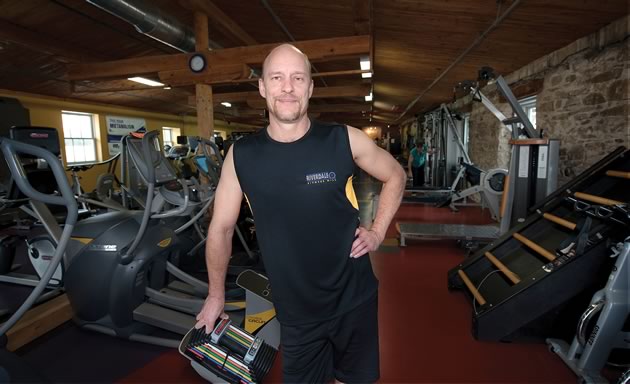
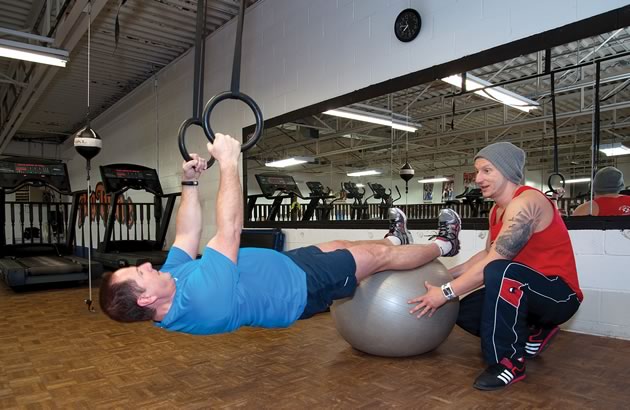
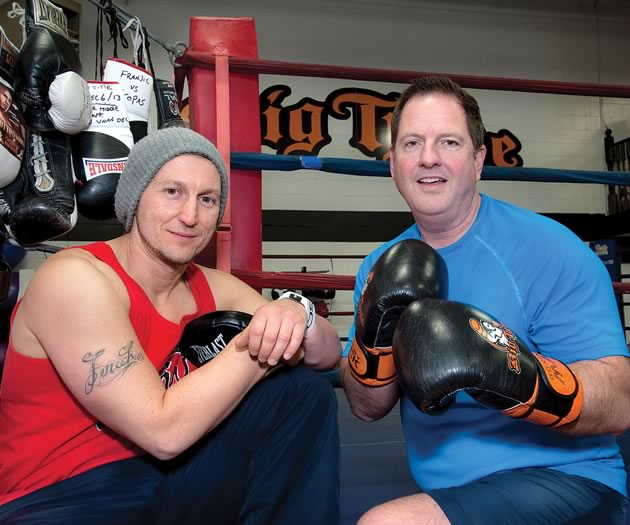
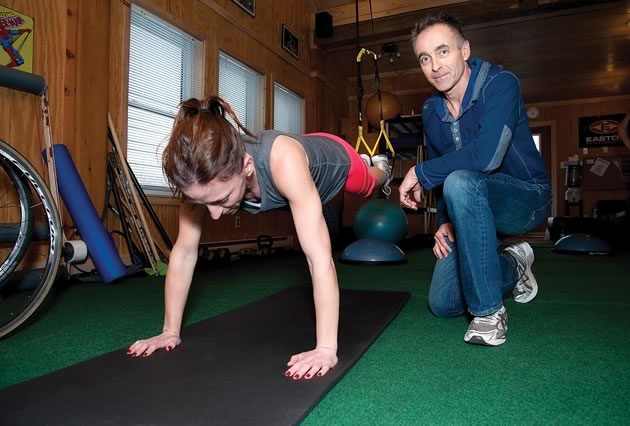
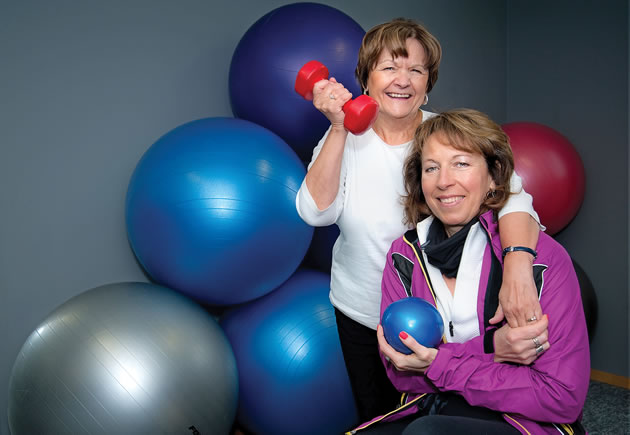
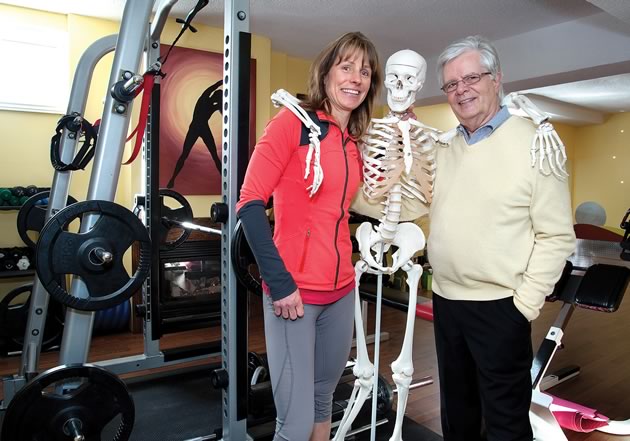
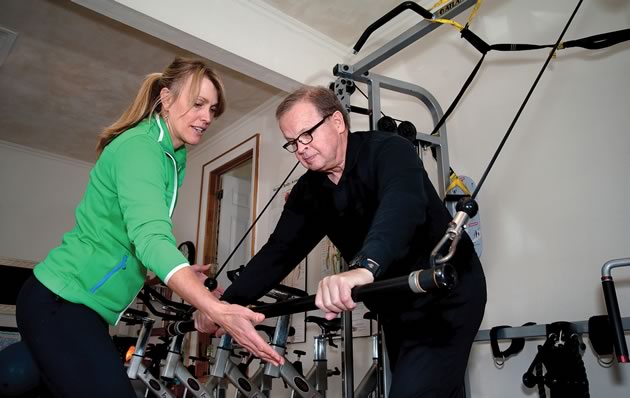







Great article!! As a Physiotherapist I see a lot of clients with “sitting induced” problems. After they are done with physiotherapy and able to train, I´d love to be able to scoot them over to a holistic lifestyle coach such as Nicola Boadway is one. She is a great in motivating people and very well educated.
Katrin Happel on Mar 31, 2014 at 5:03 am |